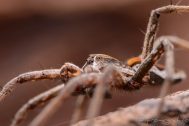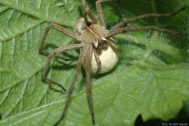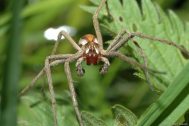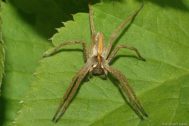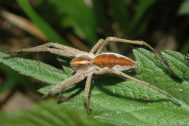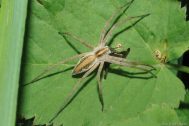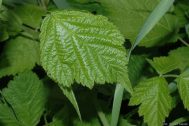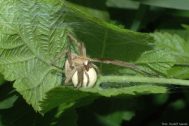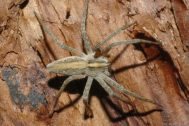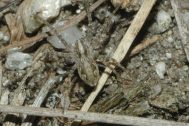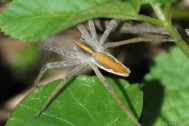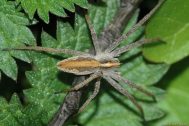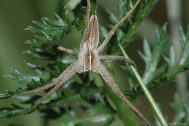| Records by time | |||||
|---|---|---|---|---|---|
| Pisauridae | 0-1900 | 1901-1950 | 1951-2000 | 2001+ | ∑ |
| Pisaura mirabilis (Clerck, 1757) Not endangered | 2× | 9× | 893× | 419× | 1323× |
Pisaura mirabilis (Clerck, 1757)
| Czech name | lovčík hajní |
|---|---|
| Threat level | Not endangered |
| Records | 1323 nálezů, 286 kvadrátů |
| First record |
1859, F. Prach, Prach 1866 |
| Last record | 2024 , Ondřej Machač |
| Distribution area | Palaearctic - E-A |
| Phytogeographic area |
|
| Původnost stanovišť |
|
| Humidity |
|
| Stratum |
|
| Osvětlení stanovišť |
|
| Hojnost výskytu |
|
| Altitude | 150-1000 |
Bibliography
Intense game grazing shapes epigeic spider communities of pedunculate oak Quercus robur plantations in anthropogenic environments
Game browsing affects nature conservation because the interests of hunters and gamekeepers often lead to high game stocking rates. However, the compositional effects of game browsing on invertebrates are insufficiently understood. We addressed the dynamics of epigeic spider communities in oak stands planted in newly formed anthropogenic environments under the facultative pressure of browsing game. The study site consisted of an open-cast lignite mine and an overburden deposit in NW Czechia. Using pitfall traps, we examined five habitat types (four transects per habitat type): Quercus robur stands ≥ 25 years of age, 12–24 years of age, and 0–2 years of age; Q. robur stands 12–24 years of age that were heavily damaged by game browsing; and sites subject to spontaneous succession for 12–22 years. We captured 9459 individuals from 134 spider species distributed unevenly across the examined habitat types. The young stands were dominated by Pardosa agrestis, Pardosa monticola, and Oedothorax apicatus, whereas Pardosa prativaga, Pardosa lugubris, Pisaura mirabilis, and Alopecosa cuneata dominated the old stands. The stands damaged by browsing had the highest species richness and were dominated by Alopecosa pulverulenta, Xerolycosa miniata, Alopecosa cuneata, and Trochosa ruricola. All the oak stands were rich in threatened species, with most (26) found in habitats damaged by browsing, whereas the youngest stands hosted the lowest number of threatened species (11). The species dominating old stands still included species that prefer greater canopy openness, such as Pardosa lugubris, whereas numerous species of central European climax oak forests were lacking. In conclusion, we identified oak stands heavily damaged by game browsing as a unique environment that shapes the community of epigeic spiders and that differs from epigeic spider communities of oak stands of various ages and those colonizing areas that are allowed to undergo spontaneous succession.
Inventarizační arachnologický průzkum části Havranického vřesoviště (Národní park Podyjí)
Klub mladých přírodovědců (KMP) při ZOO Praha, zájmový útvar pro středškolskou a vysokoškolskou mládež pořádá v rámci svého programu každoročně v období prázdnin (červenec - srpen) ekologický kurz. Úkolem kurzu je ověřit si získané poznatky a získat další zkušenosti s vědeckou prací.
V tomto roce se kurz konal v Národním parku Podyjí, kde jsme prováděli inventarizační průzkum vybrané lokality z hlediska botanického i zoologického. Součástí programu kurzu bylo i vypracování zprávy o výsledcích růzkumu, která bude poskytnuta k dalšímu zpracování správě NP Podyjí.
Gallery
Statistics
By month
By altitude
By collecting method (1321 used records)
| Pisaura mirabilis (Clerck, 1757) ES | Males | Females | Juveniles | Records |
|---|---|---|---|---|
| Smyk | 43 | 91 | 366 | 215 |
| Fotografie | 2 | 4 | 101 | 5 |
| Zemní past | 265 | 83 | 268 | 341 |
| Pozorování | 1 | 6 | 104 | 6 |
| Individuální sběr | 42 | 96 | 215 | 190 |
| Neurčeno | 73 | 228 | 96 | 492 |
| Sklepávání | 1 | 1 | 33 | 17 |
| Prosev | 5 | 9 | 39 | 42 |
| Nárazová past | 5 | 1 | 0 | 3 |
| Žlutá miska | 11 | 7 | 9 | 8 |
| Eklektor | 0 | 1 | 0 | 1 |
| Závěsné padací pasti | 1 | 0 | 3 | 1 |
| Males | Females | Juveniles | Records |
By biotope (1322 used records)
| Pisaura mirabilis (Clerck, 1757) ES | Males | Females | Juveniles | Records |
|---|---|---|---|---|
| Louky | 5 | 1 | 1 | 9 |
| Bylinné porosty břehů | 4 | 4 | 17 | 12 |
| Paseky | 5 | 10 | 34 | 19 |
| Mezofilní louky | 5 | 6 | 6 | 15 |
| Těžebny písku a jiných nezpevněných hornin | 1 | 5 | 2 | 8 |
| Mokřady | 0 | 0 | 1 | 1 |
| Suché doubravy | 14 | 11 | 13 | 17 |
| Lesy | 1 | 0 | 0 | 5 |
| Kamenolomy | 6 | 3 | 18 | 16 |
| Suché lesní lemy | 10 | 3 | 1 | 4 |
| Písčiny | 1 | 3 | 7 | 8 |
| Skalní stepi na jiných horninách | 2 | 0 | 0 | 1 |
| Mokré louky | 9 | 21 | 90 | 67 |
| Neurčeno | 184 | 279 | 189 | 648 |
| Suché louky | 5 | 13 | 118 | 54 |
| Vrbové křoviny - vlhké (vrbové) křoviny | 3 | 2 | 2 | 7 |
| Ruderály | 18 | 7 | 7 | 15 |
| Vřesoviště nižších poloh | 5 | 3 | 1 | 4 |
| Suťové a roklinové lesy | 1 | 1 | 0 | 2 |
| Lužní lesy nížin | 28 | 4 | 14 | 18 |
| Lesostepní doubravy | 4 | 2 | 10 | 11 |
| Rašeliniště | 3 | 3 | 17 | 19 |
| Lesní okraje | 6 | 3 | 42 | 19 |
| Reliktní bory na skalách | 2 | 2 | 17 | 10 |
| Travnaté stepi | 1 | 0 | 0 | 1 |
| Vlhké doubravy | 0 | 1 | 2 | 2 |
| Suché křoviny | 9 | 9 | 19 | 16 |
| Ovocné sady s luční vegetací | 7 | 1 | 5 | 11 |
| Vnější stěny budov | 1 | 0 | 0 | 1 |
| Zahrady | 0 | 0 | 2 | 2 |
| Rákosiny a orobincové porosty stojatých vod | 3 | 4 | 6 | 10 |
| Luční ostřicové mokřady | 2 | 4 | 7 | 11 |
| Xerotermní travinobylinná společenstva | 9 | 17 | 94 | 44 |
| Louky | 12 | 24 | 65 | 35 |
| Ostřicové porosty stojatých vod | 7 | 9 | 32 | 18 |
| Slaniska | 0 | 1 | 0 | 1 |
| Vlhké lesní lemy | 2 | 5 | 1 | 3 |
| Výsadby jehličnanů | 4 | 0 | 118 | 12 |
| Bučiny nižších poloh | 2 | 1 | 0 | 3 |
| Písčité břehy | 1 | 0 | 0 | 1 |
| Interiéry budov | 1 | 0 | 0 | 1 |
| Dubohabřiny | 7 | 3 | 4 | 4 |
| Zahradnicky utvářené zahrady a parky | 1 | 3 | 100 | 2 |
| Pastviny | 5 | 8 | 6 | 12 |
| Stinné skály nižších poloh | 3 | 2 | 2 | 5 |
| Okraje silnic | 1 | 3 | 4 | 2 |
| Skalní stepi na vápenci | 8 | 10 | 11 | 14 |
| Porosty borůvek | 3 | 3 | 19 | 14 |
| Ovocné sady a vinohrady | 0 | 1 | 0 | 1 |
| Močály | 8 | 11 | 22 | 25 |
| Mokřadní olšiny | 1 | 3 | 12 | 11 |
| Louky a pastviny | 1 | 0 | 10 | 6 |
| Stojaté a pomalu tekoucí vody | 3 | 1 | 3 | 4 |
| Horské bučiny | 1 | 1 | 1 | 3 |
| Úhory | 3 | 1 | 11 | 7 |
| Výsadby listnáčů | 0 | 1 | 4 | 4 |
| Břehy tekoucích vod | 4 | 7 | 18 | 14 |
| Kamenité suti nižších poloh | 4 | 0 | 0 | 3 |
| Haldy a výsypky | 0 | 0 | 5 | 1 |
| Ostatní pole | 3 | 0 | 1 | 4 |
| Polní biotopy | 0 | 0 | 0 | 1 |
| Lesy vyšších poloh a strmých svahů | 0 | 0 | 7 | 2 |
| Lesy | 0 | 2 | 4 | 2 |
| Pozemní komunikace | 0 | 0 | 3 | 1 |
| Acidofilní bory | 3 | 2 | 2 | 6 |
| Lesní cesta | 2 | 2 | 5 | 4 |
| Přirozené lesy | 4 | 2 | 22 | 8 |
| Rašelinné bory | 1 | 0 | 0 | 1 |
| Males | Females | Juveniles | Records |




